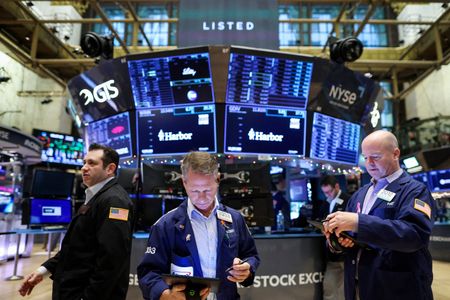By David Randall and Saqib Iqbal Ahmed
NEW YORK (Reuters) -Some investors believe a slowdown in U.S. inflation last month may be paving the way for a market-friendly “Goldilocks” scenario for asset prices, allowing the Federal Reserve to bring down consumer prices without badly damaging growth.
U.S consumer prices unexpectedly fell last month for the first time in more than 2-1/2 years, data showed on Thursday, suggesting inflation was on a sustained downward trend despite comparatively robust growth in other economic indicators such as employment.
Theoretically, the scenario could bolster the case for the U.S. central bank to ease off market-bruising rate increases sooner than projected, avoiding a widely forecast recession that many feared would further hurt the stock market after last year’s steep decline.
“Softer inflation and (the) strong jobs market do support the Goldilocks scenario, which will certainly make the rate hike discussion heated at the heart of the FOMC (Federal Open Market Committee),” said Ipek Ozkardeskaya, a senior analyst at Swissquote Bank.
The Fed has given little indication that it intends to veer from the trajectory policymakers mapped out last year. They projected their key policy rate would top out at between 5.00% and 5.25% this year, up from a current 4.25%-4.50% rate.
Market pricing indicates investors remain wedded to a more dovish view, with the policy rate peaking below 5% around mid-June before falling in the second half of the year.
‘GOOD NEWS’ ON INFLATION
For the near-term, Thursday’s data cemented expectations that the Fed would dial back the pace of its rate increases again at its Jan. 31-Feb. 1 policy meeting.
Investors are now pricing in roughly a 90% chance that the central bank will raise its policy rate by 25 basis points to a range of 4.50% to 4.75% at that meeting, up from about a 75% chance priced in on Wednesday and the 35% chance expected a month ago, according to CME Group’s FedWatch Tool. The Fed hiked rates by three-quarters of a percentage point at four straight meetings starting in June 2022 before slowing to a half-percentage-point increase at its meeting last month.
“I think it’s now clear that the aggressive single-meeting moves are behind us,” said Rick Rieder, chief investment officer of global fixed income at BlackRock, referring to the spate of 50 and 75 basis-point increases the Fed delivered last year.
Rieder believes policymakers will raise rates by 25 basis points at the next two meetings, with further 25 basis point increases possible, depending on data.
Moves in stocks were more muted on Thursday compared to the big swings seen in recent months on release dates for consumer price data. The S&P 500 index was up about 0.3%, while yields on the benchmark 10-year Treasury were down about 11 basis points at around 3.44%.
Investors in short-term options had priced in a much sharper move of about 2% going into Thursday’s CPI print, according to data from market maker Optiver. On the days of the prior seven CPI releases, the S&P 500 moved an average of 2.7% in either direction, more than double the an average daily move of about 1.2% over the same period.
“This was the first in-line CPI print in a long time and the first print in six months where it was not profitable to be ‘long volatility,'” said Hugo Bernaldo, senior cross-asset trader at market maker Optiver, in Amsterdam. “That may cause the market to rethink these going forward.”
Stocks are up 3% month-to-date, which may have contributed to the session’s muted reaction, said Charlie McElligott, equity derivatives strategist at Nomura.
“It was a bullish story, but we had traded up into it anticipating it … and that compressed the actual post-event trade,” McElligott said.
“There have been a number of discretionary, macro, tactical folks who had this disinflation Goldilocks kind of risk trade on to start the year,” he said.
Tiffany Wilding, PIMCO’s North American economist, believes the Fed is likely to raise rates just two more times this year before pausing.
They “still need to keep policy in restrictive levels, but in terms of the likelihood of needing to go much higher from here, I think that definitely is falling by the day as we’re getting more good news on the inflation data,” she said.
(Reporting by David Randall and Saqib Iqbal Ahmed; Additional reporting by Davide Barbuscia and Lewis Krauskopf; Editing by Ira Iosebashvili, Paul Simao and David Gregorio)

